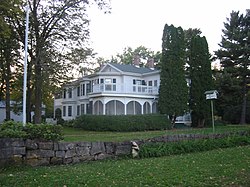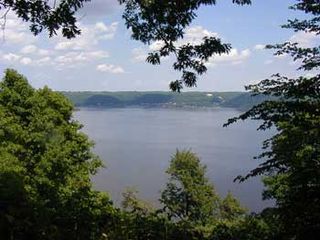Loading AI tools
Unincorporated community in Minnesota, US From Wikipedia, the free encyclopedia
Frontenac (/ˈfrɒtɛnæk/ FRON-teh-nak)[5] is an unincorporated community and census-designated place (CDP) in Florence Township, Goodhue County, Minnesota, United States, on the Mississippi River. As of the 2020 census, its population was 249.[6]
Frontenac | |
|---|---|
 Winona Cottage, a c. 1854 house from Frontenac's days as a 19th-century resort town[1] | |
| Coordinates: 44°31′26″N 92°19′52″W | |
| Country | United States |
| State | Minnesota |
| County | Goodhue County |
| Township | Florence Township |
| Area | |
| • Total | 1.85 sq mi (4.78 km2) |
| • Land | 1.84 sq mi (4.78 km2) |
| • Water | 0.00 sq mi (0.01 km2) |
| Elevation | 720 ft (220 m) |
| Population (2020) | |
| • Total | 249 |
| • Density | 135.03/sq mi (52.14/km2) |
| Time zone | UTC-6 (CST) |
| • Summer (DST) | UTC-5 (CDT) |
| ZIP code | 55026 |
| Area code | 651 |
| FIPS code | 27-22904 |
| GNIS feature ID | 643972[3] |
James Wells established a trading post in the location that would become Frontenac before 1850. He dealt mostly with Native Americans until the railroad was built in the early 1870s. In 1854, the Garrard brothers came upon the area during a hunting trip and bought large tracts of land. By 1857, the community was permanently established with the name of Westervelt in 1855 to honor the then postmaster, Evert V. Westervelt.[7]
The name was changed to Frontenac in 1860 by the Garrard brothers after Frenchman, Louis de Buade de Frontenac, who was born in 1622. He was the French colonial governor of Canada in 1672–82 and 1689–98. He died in Quebec, Canada on November 28, 1698. There is not a record of him actually traveling to the Mississippi River.[7]
Frontenac housed a station of the Chicago, Milwaukee, St. Paul and Pacific Railroad and the picturesque scenery soon began attracting wealthy residents. It became a community of summer homes with lakeside views.[7] The railway line outside the community ran from north to south, connected the remote area with larger cities, but it was far enough away from the bluffs not to detract from the vacation destination. There are actually two communities that comprise Frontenac. The railway line attracted some residents, while the bluffs attracted others. The houses along the railway line, and later the highway, became known as Frontenac Station while the bluff residences are called Old Frontenac. Both are in Florence Township and are listed as one location in the U.S. Census.[7]
According to the United States Census Bureau, Frontenac has an area of 1.846 miles (2.971 km); 1.844 miles (2.968 km) of this is land, and 0.002 miles (0.0032 km) is water.[8]

The 2010 Census only includes the Frontenac Station part.[10]
At the census[11] of 2010, there were 282 people in 114 households in Frontenac.
St John Lutheran Church is a Christian church of the Wisconsin Evangelical Lutheran Synod in Frontenac.[12] Christ Episcopal Church is also located in Old Frontenac, and features an outdoor amphitheater.[13]

The Mount Frontenac Ski Resort [14] was located on the north-western edge of Frontenac Station. It had 17 named runs, 6 lifts, and 80 acres (320,000 m2) of skiable area. Its longest run was 4,000 feet (1,200 m) in length.[15] The ski runs have been closed and are now part of an 18-hole golf course.[16]
The land between Frontenac Station and Old Frontenac, as well as much of the land to the north and some to the south, was set aside as a State Park in 1957. Frontenac State Park includes the floodplain along the Mississippi River, bluffs which are a flyway for many migratory bird species, prairies and hardwood forests. It is within the Mississippi Flyway and is also part of the Driftless Area of the north central United States.
Frontenac is located along U.S. Highway 61, which also carries U.S. Highway 63 at that point.
Amtrak’s Empire Builder, which operates between Seattle/Portland and Chicago, passes through the town on BNSF tracks, but makes no stop. The nearest station is located in Red Wing, 10 miles (16 km) to the northwest.
The Frontenac Airport is located 1 mi (1.6 km) south of Frontenac Station, and is administered by a private agency.[17]
Seamless Wikipedia browsing. On steroids.
Every time you click a link to Wikipedia, Wiktionary or Wikiquote in your browser's search results, it will show the modern Wikiwand interface.
Wikiwand extension is a five stars, simple, with minimum permission required to keep your browsing private, safe and transparent.